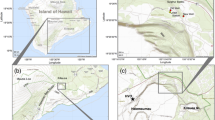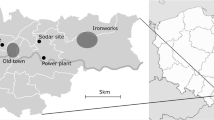Abstract
Fugitive greenhouse gas emissions from unconventional gas extraction processes (e.g. shale gas, tight gas and coal bed methane/coal seam gas) are poorly understood due in part to the extensive area over which these emissions may occur. We apply a rapid qualitative approach for source assessment at the scale of a large gas field. A mobile cavity ring down spectrometer (Picarro G2201-i) was used to provide real-time, high-precision methane and carbon dioxide concentration and carbon isotope ratios (δ13C), allowing for “on the fly” decision making and therefore an efficient and dynamic surveying approach. The system was used to map the atmosphere of a production coal seam gas (CSG) field (Tara region, Australia), an area containing pre-production “exploration” CSG wells (Casino, Australia), and various other potential CO2 and CH4 sources (i.e. wetlands, sewage treatment plants, landfills, urban areas and bushfires). Results showed a widespread enrichment of both CH4 (up to 6.89 ppm) and CO2 (up to 541 ppm) within the production gas field, compared to outside. The CH4 and CO2 δ13C source values showed distinct differences within and outside the production field, indicating a CH4 source within the production field that has a δ13C signature comparable to the regional CSG. While this study demonstrates how the method can be used to qualitatively assess the location and source of emissions, integration with atmospheric models may allow for quantitative assessment of emissions. The distinct patterns observed within the CSG field demonstrates the need to fully quantify the atmospheric flux of natural and anthropogenic, point and diffuse sources of greenhouse gases from individual Australian gas fields before and after production commences.



Similar content being viewed by others

References
Allen, D. T., Torres, V. M., Thomas, J., Sullivan, D. W., Harrison, M., Hendler, A., et al. (2013). Measurements of methane emissions at natural gas production sites in the United States. Proceedings of the National Academy of Sciences, 110(44), 17768–17773. doi:10.1073/pnas.1304880110.
Cathles, L. M., Brown, L., Taam, M., & Hunter, A. (2012). A commentary on “The greenhouse-gas footprint of natural gas in shale formations” by R.W. Howarth, R. Santoro, and Anthony Ingraffea. Climatic Change 113(525–535), doi:10.1007/s10584-011-0333-0.
Chanton, J. P., Chasar, L. C., Glaser, P., & Siegel, D. (2005). Carbon and hydrogen isotopic effects in microbial methane from terrestrial environments. In L. B. Flanagan, J. R. Ehleringer, & D. E. Pataki (Eds.), Stable isotopes and biosphere-atmosphere interactions, physiological ecology series (pp. 85–105). Amsterdam: Elsevier-Acadamic Press.
Ciais, P., Tans, P. P., Trolier, M., White, J. W. C., & Francey, R. J. (1995). A large northern hemisphere terrestrial CO2 sink indicated by the 13C/12C ratio of atmospheric CO2. Science, 269(5227), 1098–1102. doi:10.1126/science.269.5227.1098.
Corbett, J. E., Tfaily, M. M., Burdige, D. J., Cooper, W. T., Glaser, P. H., & Chanton, J. P. (2012). Partitioning pathways of CO2 production in peatlands with stable carbon isotopes. Biogeochemistry. doi:10.1007/s10533-012-9813-1.
Draper, J. J., & Boreham, C. J. (2006). Geological controls on exploitable coal seam gas distribution in Queensland. APPEA Journal, 46, 343–366.
Hayhoe, K., Kheshgi, H. S., Jain, A. K., & Wuebbles, D. J. (2002). Substitution of natural gas for coal: climatic effects of utility sector emissions. Climatic Change, 54, 107–139.
Howarth, R. W., Santoro, R., & Ingraffea, A. (2011). Methane and greenhouse-gas footprint of natural gas from shale formations. Climatic Change, 106, 679–690. doi:10.1007/s10584-011-0061-5.
IPCC. (2006). 2006 IPCC guidelines for national greenhouse gas inventories. Hayama: IPCC.
Jackson, R. B., Down, A., Phillips, N. G., Ackley, R. C., Cook, C. W., Plata, D. L., et al. (2014). Natural gas pipeline leaks across Washington, DC. Environmental Science & Technology, 48(3), 2051–2058. doi:10.1021/es404474x.
Jaramillo, P., Griffin, W. M., & Mathews, H. S. (2007). Comparative life-cycle air emissions of coal, domestic natural gas, LNG, and SNG for electricity generation. Environmental Science & Technology, 41(17), 6290–6296. doi:10.1021/es063031o.
Karion, A., Sweeney, C., Pétron, G., Frost, G., Hardesty, R. M., Kofler, J., et al. (2013). Methane emissions from airborne measurements over a western United States natural gas field. Geophysical Research Letters, 40, 4393–4397. doi:10.1002/grl.50811.
Keeling, C. D. (1958). The concentration and isotopic abundances of atmospheric carbon dioxide in rural areas. Geochimica et Cosmochimica Acta, 13, 322–334.
Kerstel, E. (2004). Isotope ratio infrared spectrometry. In P. A. de Groot (Ed.), Handbook of stable isotope techniques (pp. 759–787). Amsterdam: Elsevier.
Kerstel, E., & Gianfrani, L. (2008). Advances in laser-based isotope ratio measurements: selected applications. Applied Physics B: Lasers and Optics, 92, 439–449. doi:10.1007/s00340-008-3128-x.
Krevor, S., Perrin, J.-C., Esposito, A., Rella, C., & Benson, S. (2010). Rapid detection and characterization of surface CO2 leakage through the real-time measurement of δ13C signatures in CO2 flux from the ground. International Journal of Greenhouse Gas Control, 4, 811–815. doi:10.1016/j.ijggc.2010.05.002.
Miller, J. B., & Tans, P. P. (2003). Calculating isotopic fractionation from atmospheric measurements at various scales. Tellus, 55B, 207–214.
Moore, C. W., Zielinska, B., Pètrone, G., & Jackson, R. B. (2014). Air impacts of increased natural gas acquisition, processing, and use: a critical review. Environmental Science & Technology. doi:10.1021/es4053472.
Osborn, S. G., Vengosh, A., Warner, N. R., & Jackson, R. B. (2011). Methane contamination of drinking water accompanying gas-well drilling and hydraulic fracturing. Proceedings of the National Academy of Sciences, USA, 108(20), 8172–8176.
Pataki, D. E., Ehleringer, J. R., Flanagan, L. B., Yakir, D., Bowling, D. R., Still, C. J., et al. (2003). The application and interpretation of Keeling plots in terrestrial carbon cycle research. Global Biogeochemical Cycles, 17(1), 1022. doi:10.1029/2001GB001850.
Pétron, G., Frost, G., Miller, B. R., Hirsch, A. I., Montzka, S. A., Karion, A., et al. (2012). Hydrocarbon emissions characterization in the Colorado Front Range: a pilot study. Journal of Geophysical Research, 117, D04304. doi:10.1029/2011JD016360.
Scott, S., Anderson, B., Crosdale, P., Dingwall, J., & Leblang, G. (2004). Revised geology and coal seam gas characteristics of the Walloon Subgroup–Surat Basin, Queensland. Paper presented at the Eastern Australasian Basins Symposium II.
Scott, S., Anderson, B., Crosdale, P., Dingwall, J., & Leblang, G. (2007). Coal petrology and coal seam gas contents of the Walloon Subgroup—Surat Basin, Queensland, Australia. International Journal of Coal Geology, 70, 209–222. doi:10.1016/j.coal.2006.04.010.
Sgamma, K. M. (2012). Colarado methane study not clear-cut. Nature, 483, 407.
Sharma, S., & Baggett, J. K. (2011). Application of carbon isotopes to detect seepage out of coalbed natural gas produced water impoundments. Applied Geochemistry, 26, 1423–1432. doi:10.1016/j.apgeochem.2011.05.015.
Tait, D. R., Santos, I. R., Maher, D. T., Cyronak, T. J., & Davis, R. J. (2013). Enrichment of radon and carbon dioxide in the open atmosphere of an Australian coal seam gas field. Environmental Science & Technology, 47, 3099–3104. doi:10.1021/es304538g.
Townsend-Small, A., Tyler, S. C., Pataki, D. E., Xu, X., & Christensen, L. E. (2012). Isotopic measurements of atmospheric methane in Los Angeles, California, USA: influence of “fugitive” fossil fuel emissions. Journal of Geophysical Research, 117, D07308. doi:10.1029/2011JD016826.
Whiticar, M. J. (1996). Stable isotope geochemistry of coals, humic kerogens and related natural gases. International Journal of Coal Geology, 32, 191–215.
Whiticar, M. J. (1999). Carbon and hydrogen isotope systematics of bacterial formation and oxidation of methane. Chemical Geology, 161, 291–314.
Whiticar, M. J., Faber, E., & Schoell, M. (1986). Biogenic methane formation in marine and freshwater environments: CO2 reduction vs. acetate fermentation—isotope evidence. Geochimica et Cosmochimica Acta, 50, 693–709.
Zeebe, R. E., & Wolf-Gladrow, D. (Eds.). (2001). CO 2 in seawater: equilibrium, kinetics, isotopes. Amsterdam: Elsivier Science B.V.
Acknowledgments
The instrumentation used in this study was funded by the Australian Research Council (LE120100156). DTM is supported by an S.C.U. Postdoctoral Fellowship.
Author information
Authors and Affiliations
Corresponding author
Rights and permissions
About this article
Cite this article
Maher, D.T., Santos, I.R. & Tait, D.R. Mapping Methane and Carbon Dioxide Concentrations and δ13C Values in the Atmosphere of Two Australian Coal Seam Gas Fields. Water Air Soil Pollut 225, 2216 (2014). https://doi.org/10.1007/s11270-014-2216-2
Received:
Accepted:
Published:
DOI: https://doi.org/10.1007/s11270-014-2216-2



